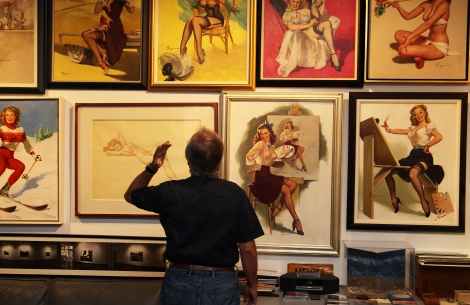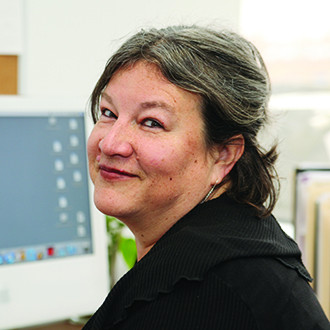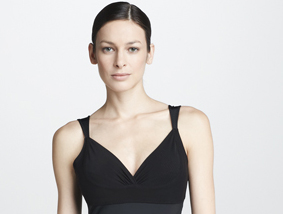Girls, girls, girls!
SoHo gallery a pinup paradise
By Mary Shustack
Photographs by Bob Rozycki
Louis Meisel isn’t surprised that for many, the word pinup brings to mind the classic “Vargas girl.”
After all, the art dealer and collector says the iconic works of Peruvian painter Alberto Vargas brought an idealized image of women to a wide audience through the pages of Esquire and later, Playboy, magazines.
“Vargas is the biggest name, because Playboy had six million copies out every month,” Meisel says.
But the Manhattan-based dealer – who’s not only a Photorealism authority but also pinup expert – is more than happy to share a glimpse into the world of pinups that goes far beyond those Vargas girls so popular that their images even graced World War II airplanes.
At the Louis K. Meisel Gallery in SoHo, pinups not only from Vargas but also from Gil Elvgren, Zoë Mozert, Mel Ramos, Greg Hildebrandt and Hajime Sorayama were prominently featured in the recent (and extended) exhibition “Lots’a Naked Ladies … And One Guy.”
No matter the featured show, though, the Meisel gallery has become the destination for savvy pinup collectors from around the world. And Meisel is a collector himself, with a staggering array of works he integrates into the exhibitions. They also have a prominent position in his wonderfully eclectic art-filled home above the gallery, where he not only showcases noted work from Charles Bell, Ramos and dozens of others, but also Clarice Cliff art pottery, vintage ice-cream scoopers, charming genie bottles and official Miss America photographs.
The man, it must be said, is a collector – “It’s what my life has been about” – who knows his stuff. And he is happy to discuss the finer points of the pinup as he walks a visitor or two through the public and private segments of his collection.
Meisel, who with his late business partner Charles G. Martignette, wrote the definitive “The Great American Pin-Up,” formally got into the work in the 1970s.
But the Brooklyn native, who was also raised in Teaneck, N.J., was a fan from the start.
“When I was growing up in the ’50s, the pinup was a big thing, the Playboys and the calendars,” he says.
When he became a dealer, first opening up on Madison Avenue and settling into SoHo in 1973, a major purchase of pinups got the 40-year odyssey under way.
As with any collection, the key is to “find something that people have not paid attention to,” and then, it was the pinup. It complemented, he says, a style he has long championed.
“American pinup artists were also doing this great realism.”
Meisel will share stories of Martignette (“He was like a detective”) unearthing collections in the unlikeliest of places, of finds they came across and deals they made.
T&A
“The golden age of the pinup is really the ’50s,” Meisel says.
But it certainly dates from at least the 1920s, with artists such as Howard Chandler Christy and continues through today.
Vargas, he says, exemplified the era of innocent appeal, with women often buying his work, Meisel says.
“You could buy it and send it to your boyfriend, husband … soldiers overseas.”
From the 1940s into the ’60s, the featured models, whether in evening gown or modest swimsuit, shared a common theme.
“She was sexy but chaste,” Meisel says. They were reflections of the girls the soldiers came home to marry. “It’s not really about nudes.”
With the growth of feminism, the golden age of pinups was over. “It changed and it stopped.”
Today, the focus is different.
While artists such as Hildebrandt and Sorayama continue to create works, there is a different feel.
“In those days, it was basically legs and breasts, there was no ass,” he says. “Now, it’s tits and ass.”
A walk through history
“The pinup room is in here,” he says, leading the way to a treasure trove filled with original art and related ephemera.
There are calendars made for NAPA Auto Parts, with the original art just inches away. There are examples of Miss Sylvania and early ads for Coca-Cola, of themed campaigns and one-of-a-kind treasures.
Through each example, he is able to illustrate a point, a trend, a style.
“The documentation that I’ve got here is endless,” he says.
All of the works are precious to him.
“I’ve had hundreds and hundreds and hundreds,” he says. “I’ve kept the best. They are not for sale.”
Today, he says, collectors will find high asking prices for original works, often starting at six figures. Mass-produced items, such as the calendars, might be scored for a few hundred.
But no matter the price point, Meisel says the majority of pinup collectors are led by the aesthetic.
“They buy it because they love it,” he says. “They’re not investing. It’s for nostalgia.”
And with so many of the works not surviving because of the materials, from paper to pastels, it becomes tougher to find prime examples.
“It’s a very limited supply,” he adds.
But not at Meisel, where the owner himself likes to be sure all who enter enjoy their visit.
“When people come to this gallery, they have fun.”
The Louis K. Meisel Gallery is at 141 Prince St., Manhattan. For more details, visit meiselgallery.com or call (212) 677-1340.



